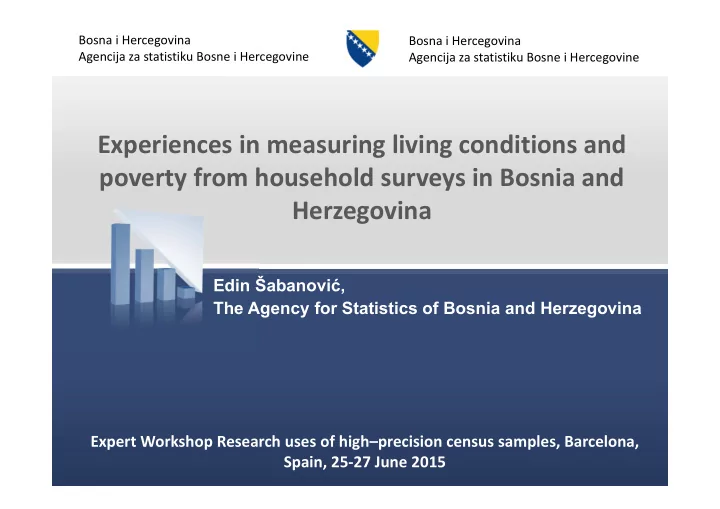

Bosna i Hercegovina Bosna i Hercegovina Agencija za statistiku Bosne i Hercegovine Agencija za statistiku Bosne i Hercegovine Experiences in measuring living conditions and poverty from household surveys in Bosnia and Herzegovina Edin Šabanovi ć , The Agency for Statistics of Bosnia and Herzegovina Expert Workshop Research uses of high–precision census samples, Barcelona, Spain, 25 ‐ 27 June 2015
CONTENT • Background • Poverty analysis based on LSMS ‐ Living Standard Measurement Survey • Poverty analysis based on HBS ‐ Household Budget Survey • New activities on poverty analysis: EU ‐ SILC introduction in B&H • Future work 2
BACKGROUND • After the war in B&H, there was a lack of household and population data • Population data from the Census 1991 become out of date because of significant demographic changes and population migrations during and after the war • About 1 mil. people have left the country, thousands have been displaced within the country, a lot of villages were devastated • Register of spatial units has become completely unusable 3
POVERTY ANALYSIS BASED ON LSMS (1) • First household survey was LSMS ‐ Living Standard Measurement Survey 2001 • First sampling frame created by enumerating all households and population in the sample of 25 municipalities (14 in Federation BiH and 11 in Republika Srpska entity) • Br č ko was excluded because of political problems • LSMS net sample of size 5402 HHs was representative at state, entity and urban/rural level (3002 HHS in FBiH, 2400 in RS) 4
POVERTY ANALYSIS BASED ON LSMS (2) • Absolute poverty measure was applied on consumpion data • LSMS continued as a panel survey called „Living in BiH“ in 2002 ‐ 2004 (n=3000 HHs) • Full scale LSMS repeated only in 2004 5
POVERTY ANALYSIS BASED ON HBS(1) • HBS was introduced in 2004 and repeated in 2007 and 2011 • HBS 2015 in process • Three Master samples were created in order to establish sampling frame for household based surveys • MS 2003 (750 EAs; 40,000 HHs) • MS 2006 (1500 EAs; 80,000 HHs) • MS 2009 (1500 EAs; 80,000 HHs). It is still in use 6
POVERTY ANALYSIS BASED ON HBS(2) • All samples selected from MS were representative at country, entity and urban/rural level • Net sample size of about 7500 HHs • NUTS classification not defined and used as a temporary version • There is a need for surveys which are respresentative at lower level of administrative organisation of the country (cantons/regions, municipalities, ethnic groups) 7
POVERTY ANALYSIS BASED ON HBS(3) • Regional disparity studies made by UNDP • Data at the level of 17 cantons/regions and 142 municipality • Limited number of variables available • Statistical offices do not produce such kind of data because of lack of population census data • Population census was conducted in October 2013 but results are still not available 8
NEW ACTIVITIES ON POVERTY ANALYSIS: EU ‐ SILC INTRODUCTION IN BIH • Pilot SILC conducted in 2015 within IPA 2012 programme • Income approach to measure the poverty • Better harmonisation to EU standards 9
FUTURE WORK • Full scale BiH SILC as regular annual survey from 2017 (?) • HBS BiH as regular survey in 5 ‐ years periodicity • Sample for household surveys selected from census sampling frame • NUTS classification finalized and implemented • Possibility for data production at lower level of the administrative/regional organisation of the country 10
Thank you for your attention! Edin Šabanovi ć edin.sabanovic@bhas.ba
Recommend
More recommend